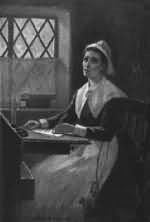Anne Bradstreet (c. 1612-1672) was a Puritan, wife, mother, and First Lady of the Massachusetts Bay Colony. She was also America’s first published poet. We don’t normally think of Bradstreet as a storyteller, but I think there’s a gem of a story tucked into her poem, “Here Follows Some Verses Upon the Burning of Our House, July 10, 1666.”
Sure, the poem includes religious pieties – a toeing of the church’s party lines, as it were. Our treasure is in heaven, so we shouldn’t get too attached to the things of this world: “I blest His name that gave and took.” She writes,
Yea, so it was, and so ’twas just.
It was His own, it was not mine,
Far be it that I should repine;
He might of all justly bereft
But yet sufficient for us left.
The poem ends,
Farewell, my pelf, farewell my store.
The world no longer let me love,
My hope and treasure lies above.
Fine enough. We see that Bradstreet is a devout, faithful, trusting Puritan.
But the story that Bradstreet tells throughout the poem is markedly different from the religious pieties she expresses. The story flashes out and rings truer than her protestation that she will no longer love the things of this world.
The poem opens with the setting of the scene: “In silent night when rest I took / . . . I waked was with thund’ring noise / and piteous shrieks of dreadful voice” and the “fearful sound of ‘Fire!’ and ‘Fire!’”
As the poem moves on, Bradstreet speaks openly and honestly about all that she’s lost in the fire that destroyed her home. As she walks past the charred “ruins,” she can’t help but look at the spot where her home once stood: “Here stood that trunk, and there that chest, / There lay that store I counted best.”
And she remembers, in perhaps the most powerful lines of the poem, all the memories she has of the events that transpired in that house:
Under thy roof no guest shall sit,
Nor at thy table eat a bit.
No pleasant tale shall e’er be told,
Nor things recounted done of old.
No candle e’er shall shine in thee,
Nor bridegroom’s voice e’er heard shall be.
Bradstreet concludes the poem with lines in which she seems to try to convince herself that God knows best and that her treasure lies, as she says, in heaven.
But oh, when you read the whole poem and see her mourning the loss of her bridegroom’s voice, her early married days, when you see her struggle to walk past the site and not sneak a look (even though she knows she shouldn’t), oh, then, you witness the actual, flesh-and-blood woman who was Anne Bradstreet. Bradstreet includes the date of the fire in the poem’s title. Perhaps this was her way of indicating the power of that experience, the specificity of the moment. This happened, and it happened on July 10, 1666.
Bradstreet most prided herself on her “Contemplations,” a lengthy series of metaphysical poems. I don’t want to take away from the importance of these religious meditations, but I feel that the real power of her work lies in the poems where she speaks to her earthly existence, her lived life as a leading Puritan in the American colonies.
After all, isn’t this a poem we’re still reading and talking about?
If you’d like an inexpensive introduction to Bradstreet’s poetry, you might be interested in To My Husband and Other Poems. Other available volumes include The Tenth Muse
(Bradstreet’s first volume of poetry, published in 1650); Several Poems Compiled with Great Variety of Wit and Learning, Full of Delight
; and The Works of Anne Bradstreet
. And if you want to go all scholarly on us, check out Wendy Martin’s excellent critical study, An American Triptych: Anne Bradstreet, Emily Dickinson, and Adrienne Rich
.
Don’t forget to leave a comment on this post! If you subscribe to the weekly StoryWeb email and leave a comment here, you’ll be entered into a monthly drawing to win a StoryWeb T-shirt.
Listen:
Listen as I read “Here Follow Some Verses Upon the Burning of Our House, July 10, 1666.” The clip runs 2:33.
Podcast: Play in new window | Download
Subscribe to StoryWeb in iTunes.Subscribe to StoryWeb in Stitcher.
This 19th-century painting is in the public domain.
